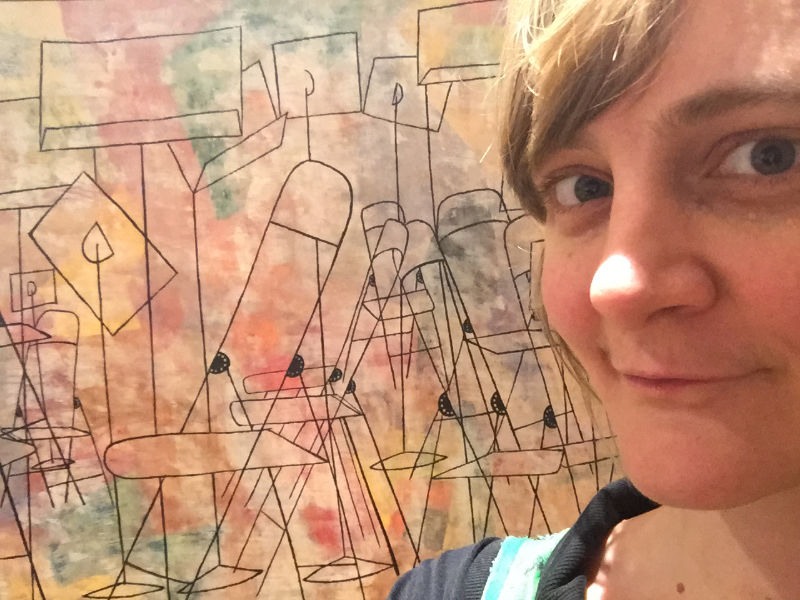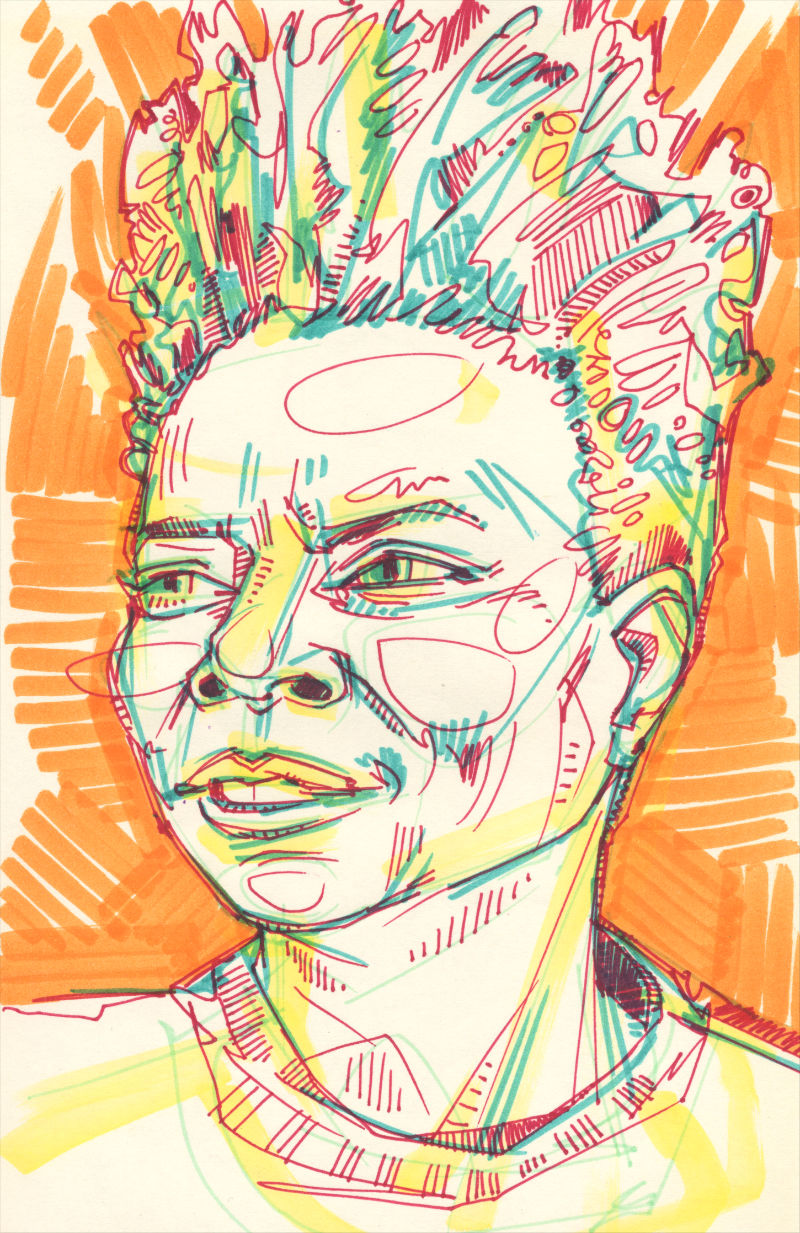Blog / 2019 / Job with Justice Travel Log, Part 1
March 20, 2019
I’m contributing to a book about collective bargaining and how it can be used by more than just labor unions. Since I’ll be painting portraits of the workers whose stories are featured in the book, I’ve been doing a lot of traveling to meet these workers and photograph them. What follows are some of my notes from my travels.
Pleasant Valley, West Virginia
January 29
We met up with Allyson and Heather, teachers who helped organize the work stoppage in West Virginia last year. Two themes stand out to me from our conversation.
For one thing, it’s clear that teachers in West Virginia would have put up with a lot—with low pay and the expectation that they will act as way more than just teachers to the kids—because they believe in the work they’re doing. But the state pushed them too far on healthcare.
Specifically, it’s when the government introduced a tracking app that the teachers realized they could not roll over. Under the new health insurance plan, teachers would be penalized if they did not buy a smart phone and download the app to follow their daily activity. The app meant, among other things, that, if teachers didn’t get enough steps in each day, their insurance costs could go up.
From what I can tell, the teachers’ outrage stemmed mostly from the paternalistic nature of the app, but I like to think it might also signal a shift in how people are thinking about the right to privacy more generally. Since 9/11, state surveillance of citizens has grown exponentially, so privacy is obviously important, but there’s more to it as well. A woman’s right to choose—along with all the rights and possibilities that this one right engenders—rests heavily on her right to privacy, legally speaking. It pleases me to think that, as people stand up for their right to privacy, they are also indirectly standing up for women’s rights.
The second part of the interview that really piqued my interest goes back to the teachers’ belief in the work they do. Allyson pointed out that, when teachers’ unions fight, they fight for the future in a straightforward way. I mean all unions fight for economic justice, which is, of course, related the future of our society, but teachers’ unions are tied to the future in more explicit manner, since the work of teachers is to personally shape the individual humans who will make up our future world.
Washington DC
January 30
I got a peek into the way the sausage is made! I didn’t witness any of the back room negotiations that I know happen in the making of a law, but I did see a part of the process that I didn’t even know existed.
I went with Smiley (one of the co-authors of the book) to a briefing on the Hill. She was participating in a panel discussion about the $15 federal minimum wage. The event was put together by the Century Foundation, a think tank, and its intended audience was the staffers of our legislators.
The discussion touched on the expected points about a living wage fostering an economy that could really thrive, but there was also some back-and-forth. One of the staffers brought up the pitiful wages paid to prisoners and how this amounted to a new kind of slavery. (The proposed $15 federal minimum wage law would not address this issue at all.) And then there was a bout of unimaginative trolling by some libertarians who thought they were contributing to the event.
In the end, the discussion was mostly about helping staffers learn how to talk about about a $15 federal minimum wage in an effective manner, with the understanding that they would transmit this information to their bosses. It was a kind of mini-school in marketing the idea of a $15 federal minimum wage. It makes perfect sense that this would be part of a bill’s process, but I’d never thought of it until I was in the room.
Washington DC
January 31
I had some time before my last interview for this trip, so I stopped by the Phillips Collection. While there, I had three delightful encounters.
The first involved two large impressionist paintings, one figurative and one a landscape. Generally speaking, I’m more attracted to art with people in it, so I was surprised to find that, while the figurative piece left me cold, the landscape moved me to tears. I realized that the difference had to do with size. The figurative piece was maybe 5 by 6 feet, but the landscape was closer to 7 by 10. Those extra square feet made all the difference for me. New goal: make really big art.

I also got to see Ben Shahn’s work in person for the first time ever. This is important because, back in 2003, right after I finished school, I devoured his book The Shape of Content, and his words shaped my content irrevocably, making me the artist I am. And it’s especially fitting that I’d have this experience, because Shahn was a lefty radical whose work was not given its proper due by the mainstream art world. In the post World War II period, the US art scene was heavily funded by the CIA’s propaganda division with the aim of promoting abstraction, which the government was hyping as the quintessential expression of American individualism—AKA the reason why Jackson Pollock became a star and Shahn did not. I’d like to think Shahn would have appreciated the book project I’m working on.
Last but not least, I got to spend a few minutes in Wolfgang Laib’s Wax Room, a closet-sized art installation that is exactly what the title suggests. Standing in this small space surrounded by bee’s wax was more moving than I expected. It was a delightfully organic experience, especially considering I was in a human-made space. Please visit Wax Room if you find yourself in DC!

Kimberly
2019
marker on paper
8 x 5 inches
Later that day, Sarita (the other co-author) and I met up with Kimberly, a beautician from a department store. Her interview, like all the interviews for the book, was about not only her advocacy on behalf of workers’ rights, but also her life and struggles in her off-time. Kimberly shared about her joys and disappointments in a very stream-of-consciousness manner, and I found myself wishing I was more in control of the interview process than I was. There were so many moments in the interview when I would have asked Kimberly for clarification on what she was saying.
But Sarita and Smiley are following interview advice from a specialist who works for Rutgers. They focus on making space for a person to speak, instead of cutting them off with questions and comments. As frustrating as this method was sometimes, I learned a lot from it, and it’s definitely something I’m going to fold into the interviews I do for my regular portrait work.
Getting out of my studio is always a bit of an effort. I love working for myself and by myself. But I also know that, for me, collaboration is the only real way to grow. That’s actually part of the reason why I have always painted portraits, and this project is like my usual collaborative portrait process but exaggerated and expanded. That is a very good thing.
UPDATE
March 10, 2022
You can see all the paintings from this project here, and the book, The Future We Need, is now available!
For more information about this project and to see images of the works in progress, check out these posts:
- Job with Justice Travel Log, Part 2
- Job with Justice Travel Log, Part 3
- Job with Justice Travel Log, Part 4
- Job with Justice Travel Log, Part 5
- Why Artists Should Be Paid Every Time They Exhibit
- My Non-artist Résumé
- Tips for Painting Portraits from Other People’s Photos
- The 2 Kinds of Art Patron
- Painting a Black Person’s Portrait Versus Painting a White Person’s
- How Art Lovers Can Help Fix Art World Inequalities
- A New Kind of Series
- Your Worth Is Not Determined by How Much Money You Make
- The Future We Need
- Art That Saves the World
- New York City Art and My 19th Artiversary
Maybe this post made you think of something you want to share with me? Or perhaps you have a question about my art? I’d love to hear from you!
To receive an email every time I publish a new article or video, sign up for my special mailing list.
If you enjoyed this post, Ko-fi allows you to donate. Every dollar you give is worth a bajillion to me!



